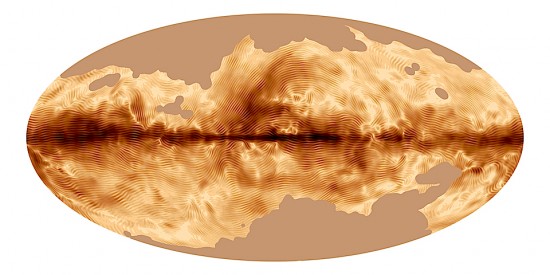May 15, 2014
Electromagnetic fields guide light in specific ways.
The image above is from the Planck satellite, now defunct, that was launched by the European Space Agency (ESA) in May 2005, along with the Herschel Space Observatory, which also recently ended its mission.
According to ESA, Planck’s mission was broken into several objectives: to determine the large-scale properties of the Universe with high precision; to test theories of inflation; to search for primordial gravitational waves; to search for “defects” in space; to study the origin of the structures we see in the Universe; and to study our and other galaxies in the microwave.
Planck used its detectors to investigate polarized light coming from various locations in the Milky Way. According to a recent press release, small dust grains, said to be rotating at several million times per second, are constrained by magnetic fields that cause them to form field-aligned channels through which light is emitted. That causes the light to be polarized. However, could the information be relevant to another explanation that involves electrical activity?
Data the Fermi Gamma Ray Space Telescope revealed twin lobes of a gamma rays in an hourglass shape extending out beyond the Milky Way’s central bulge. Each structure measures approximately 65,000 light-years in diameter. The funnel-like formations are the unmistakable signature of Birkeland currents squeezing plasma and charged dust into z-pinch compression zones. The intense magnetic fields associated with Birkeland current filaments cause electrons to accelerate with velocities close to light speed. Those excited electrons emit synchrotron radiation, the principle source for gamma rays in space.
Electric Universe advocates have long known that “radio lobes” far above the poles of active galaxies are the signature of Birkeland currents that often resolve into braided filaments, while the spiral arms of some galaxies exhibit twisted strands of material extending from their cores.
All those filaments are Birkeland currents, but they represent only the visible portion of an entire circuit. As more data accumulates from an ever-increasing array of telescopes, such as Planck, it is becoming increasingly obvious that the Milky Way shares characteristics with the rest of its galactic family. A halo of stars, filamentary structures, lobes of radiation, a microwave “haze,” and other observed phenomena point to its electrical nature.
Rotating dust grains are not the most likely reason that Planck found polarized light. ESA refers to “magnetic fields” in its announcement, but for magnetic fields to exist, electric fields must also be present. It is an electromagnetic force, not merely a magnetic force that guides light waves. Provided that the Planck detectors actually saw what was reported, polarization in the Milky Way could be caused by the Zeeman effect.
The Zeeman effect is named for Pieter Zeeman, a Dutch physicist. It splits spectral lines in the presence of a magnetic field, and consists of triple or double splitting of the spectra. Based on the direction of detection, polarization of the split lines is different: circular polarization occurs in the longitudinal rotation for the two high and low bands of a triplet, while in the middle, or transverse band, light is polarized parallel to the magnetic field, and the other two bands are perpendicular.
Since the Milky Way is threaded with filaments of electromagnetic Birkeland currents, it could be that Planck is seeing polarization from the fields associated with them.
Stephen Smith













